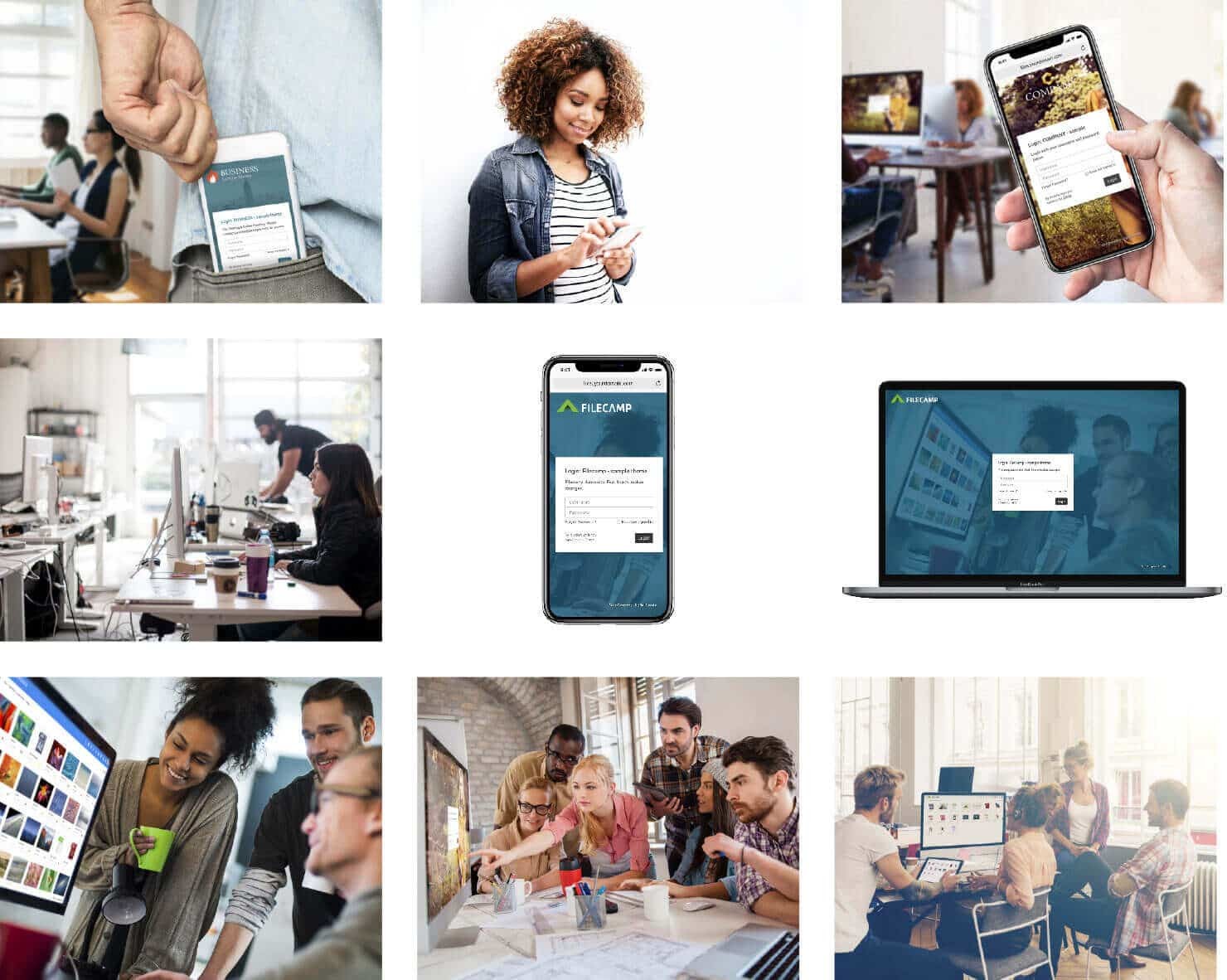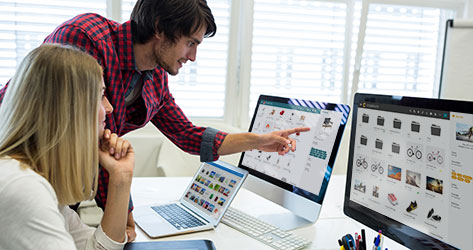Brand Assets - What They Are and How to Leverage Them
Building a brand is all about how you present yourself to the world. It’s how you choose to tell your story and what makes your company, service, or product what it is.
In the digital era, having a well-established brand can attract more potential buyers, improve customer experience, and set your company apart from the competition. In short, a strong brand can pave the way to business growth and success.
With so many benefits, the next question is how can you build a strong brand? What are the elements required?
The answer lies in brand assets. In how you choose them, create them, and how you use them to tell a consistent story. Keep reading to find out all about what brand assets are and how to leverage them to increase your chances for success.
What Are Brand Assets?
Brand assets, just as the name suggests, are the elements or resources that make up your brand and help convey your brand’s message to audiences. It’s the assets you consistently use in your marketing strategies and your communications that people associate with your brand.
The logo is perhaps the most popular type of brand asset. Just think about what comes to mind when you say Nike or Apple. For Nike, it’s the swoosh logo, for Apple it’s the bitten apple logo.
When people see any of these logos, they instantly know what brand to associate them with.
However, a brand can have a multitude of brand assets that it needs to manage. From a special color palette to one-of-a-kind graphics, a unique song, or a particular smell.
This is perhaps what we could call the magic of brand assets. They can be so diverse and so different that they leave each brand room to send a message as creative or as unique as they want it to be.
What Brand Identity Elements Qualify as Brand Assets?
There are many elements that make up your brand and that you use to communicate your brand messages and promote your marketing strategies. Some are palpable like your company name or logo. Others are not. Like Coca-Cola or KFC’s secret recipes.
Only some of these assets are considered brand assets.
To qualify as a brand asset, a brand identity element must meet two essential conditions. It must be unique and recognizable, something that automatically tells people what brand the message is from.
This includes specific elements like:
- your company’s motto, slogan, or tagline
- the company’s logo
- visual elements like fonts and color schemes
- a unique jingle, sound, or song associated with your brand or your products
- your product packaging
- a special smell associated with your product
Famous examples of well-established brand assets include:
- the Nike swoosh
- Adidas’ three stripes
- Apple’s logo
- Coca-Cola’s unique bottle shape
- the golden arches from McDonald’s
Any branding elements that are more generic, that your audience does not instantly associate with your brand are not considered brand assets.
Brand Asset Benefits
Ok, so everyone (me included) says brand assets are an asset, a resource you should learn to make the most of.
However, you may be wondering how exactly do brand assets benefit your company, product, or service? How do they promote your business and build a positive image for your brand?
The most valuable benefit brand assets can offer is recognition. That instant association a potential customer makes with your brand as soon as they lay eyes on a specific brand asset.
In physical products, it can be just a label, ic Coca-Cola would make a chewing gum you would be more inclined to by it, because of brand asset recognition. In digital business is can for example be as simple as an outreach email, as you would pay more attention to an email from Notion than from a no-name brand - but this is just the top of the iceberg.
This instant recognition is at the core of the main benefits brand assets offer.
Brand assets can:
- help build and reinforce your brand image and identity
- create positive associations in the mind of the potential buyer
- increase the likelihood of potential customers having positive feelings about your brand and purchasing your product or service
- boost customer experience by helping customers connect with your brand on an emotional level
- build loyalty
Thanks to the positive feelings and associations they create, brand assets can:
- attract new audiences and more potential customers
- increase the effectiveness of your cold email campaigns
- streamline the buyer’s journey and increase conversion rates
- help build brand loyalty and promote your brand even further
How to Identify Your Brand Assets
Still not sure what your brand assets are or even if you have any? No worries. The truth is that it can sometimes feel complicated to narrow down exactly what makes your brand recognizable.
Luckily, there are some foolproof ways to do this. Here is how you can easily identify your brand assets so you can put them to work:
Review the elements that make up your brand identity
What you need first is to go through all the major elements that you use in your brand communication. Everything may play a role in correctly identifying your strongest brand assets. However, you don’t have to go too crazy with the details either.
Carefully comb through relevant assets like your logo, your brand name or product names, your fonts, color palettes, graphics style. Or, specific images or videos.
See what stands out as having the potential to be most associated with your brand image. Specifically, identify what you think people recognize about your brand most often. What makes them instantly think about your company or products?
Next, divide these elements into separate categories. One category could be visual or audio elements, another could be brand name-related elements. You will be using these to gather valuable data that will help you identify your most important brand assets.
Ask your customers what elements they most associate with your brand
Now that your ducks are in a row, it’s time to get feedback. While you may think one asset is more recognizable than another or your team may see things a certain way, the most important feedback you can get is from your audience and your customers.
Conduct surveys to determine which elements people most often associate with your brand or products. See how often they immediately recognize a brand asset as being one of your own. Also, check if one of your brand elements gets confused with a competitor’s brand.
It’s vital that you collect data on how unique your brand elements are.
Next, make sure the data you collect also includes details about the customer. Things like their age and other demographic data, as the feedback you receive may be different depending on who is answering the question.
This will also help you better plan your marketing strategies. You will know which groups respond better to which elements and you will be able to target your campaigns better. It will also help you determine which assets have the most potential and which ones you can maybe drop.
Use an asset grid to categorize your findings
Once your research is complete, you will be able to categorize the brand assets you initially considered into one of the following four categories:
- Avoid – brand elements that are irrelevant to your brand or associated with a competitor
- Use/Lose – resources that you can use to replace or complement others
- Ignore/Test – elements that do not strike any chord in your audience
- Invest Potential - brand elements that have the potential to become strong brand assets that win you recognition but need work or more promotion

How to Leverage Your Brand Assets
The key element to building a brand asset that will instantly be associated with your company, product, or service and that will positively promote your business is consistency.
In the end, it’s all about:
- the elements you choose to make up your brand assets
- how you choose these elements
- how you organize and distribute them to your audience
Be consistent and organized
Consistency is what makes a brand asset what it is and it’s what gives it its value.
Internationally recognized brands stay true to their brand image by consistently using and incorporating their most significant brand assets into every line of communication they have with their audience. Be it customers, partners, suppliers, vendors.
Once you’ve identified what brand assets already make your brand recognizable and what assets you can invest in to further supplement the value of those assets, include them in all your communications.
Use your brand assets:
- on your packaging
- across all your brand’s communication channels
- when building your SEO strategies
- in the social media content, you share
- in your online marketing and email marketing strategies
Strengthen your brand assets by making sure they are supported by clear brand guidelines and rules. This includes everything from color to size variations, tone of voice, or terminology.
Your brand assets should be coherent, constant, and used by every one of your teams in the same manner. You can’t have 6 different versions of the same logo or 3 different color palettes. And you can’t have your marketing team creating its own version and your sales team using another.
To facilitate everyone’s access to the approved versions and avoid any errors in using the brand assets, use a system to centralize them. This way, when anyone needs to use a brand asset, they know exactly where to find it.
This will help you improve your workflow and save resources and time. Not to mention help you avoid unnecessary frustrations.
Continue to Collect and Analyze Brand Asset Data
Your work collecting and analyzing feedback on how your brand assets are perceived does not end once you’ve identified them. Make it a point to regularly reassess how audiences perceive your brand and products and what elements they most associate with them.
This will help you stay on track with your brand guidelines and customize your messages for different groups of potential customers.
Extend Your Brand’s Reach
Yes, brand assets will attract more potential customers and they will help you build a loyal following. Those are indeed very valuable benefits to any business.
However, once you’ve established your main brand assets, one of the best ways to leverage them is using them to expand your business.
One example is creating and launching a new product or a new product line. In such cases, your brand assets will be the ones paving the way for the new products to become successful.
For instance, let’s say your company sells sneakers under a certain brand name, with a certain logo or pattern. A brand name that customers and potential customers easily recognize.
If your brand is established, your audience should already be associating your brand with positive attributes. Like “reliable”, “comfortable”, or “fashionable”. So, when you decide to introduce a new line of sneakers, you won’t have to go through the same motions a new company launching a new product would.
Your audience will already know your value proposition, the benefits of choosing your brand. And, as soon as they see your logo or your specific pattern, they will know what the company selling the sneakers is.
In the same way, you can use brand assets to expand your brand by accessing a new product category.
For instance, let’s say your brand is often associated with the term “luxury”. When potential customers see your logo, they instantly think “premium product”. This allows you to choose from a wide range of product categories to develop further.
Ideally, you will be targeting product categories that relate to the one your brand is established for. For example, you could be selling luxury purses now and expanding your business to include products like travel bags or suitcases.
Other examples of new directions you could be expanding your brand to using your brand assets include:
- developing complementary products such as socks or sports gear if you sell sneakers
- creating items for specific customer base categories such as a line of baby shampoo if you sell shampoos or other hair care products
- using your brand authority to access new markets like Apple did when they used their reputation as quality computer manufacturers to start selling other electronics like iPhones and iPods

Andy Cabasso
Share this Post
